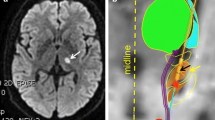Abstract
Thirteen patients with Wallenberg's lateral medullary syndrome (WLMS) were studied. Clinical and magnetic resonance imaging (MRI) evidence demonstrated infarction in the dorsolateral medulla which produced loss of pain and temperature sensation on one side of the face ipsilateral to the lesion in seven patients. However, in another six patients, the infarction in a similar location produced the same sensory loss on the contralateral face. This is the first report of an analysis comparing these two conditions in WLMS patients, confirmed by MRI. The finding of normal blink reflex and somatosensory evoked potentials (stimulation on median nerve) in the two groups of patients may indicate that the impulses travel along the central pathways of touch, vibration and joint position sensation instead of the pathways for pain and temperature, because the patients had normal sensation of touch, vibration and joint position but impairment of pain and temperature sensation. In addition, it is suggested that the pathways of late blink reflex (R2) pass through the medial lemniscus in the ventromedial medulla instead of the spinal trigeminal tract in the dorsolateral medulla. Further, the observation of the much longer lantencies (about 29 ms) of the normal R2 raises the possibility that the impulses may travel along the longer pathways through the opposite medial lemniscus and up to the thalamus or cortex where they project to bilateral motoneurons of the orbicularis oculi muscles. Although the alternative of R2 travelling only by the shorter pathways through the brain stem is not excluded, this is not supported by current data.
Similar content being viewed by others
References
Amantini A, Arnetoli G, Rossi L, Salviati A, Rizzuto N, Zappoli R (1982) BAEP and autopsy findings in Wallenberg syndrome. Ital J Neurol Sci 3:237–240
Awad I, Johnson PC, Spetzler RF, Hodak JA (1986) Incidental subcortical lesions identified on magnetic resonance imaging in elderly. II. Postmortem pathological correlations. Stroke 17:1090–1097
Chia LG, Chu FL (1985) A clinical and electrophysiological study of patients with polychlorinated biphenyl poisoning. J Neurol Neurosurg Psychiatry 48:894–901
Dengler R, Kossev A, Gippner C, Struppler A (1982) Quantitative analysis of blink reflexes in patients with hemiplegic disorders. Electroencephalogr Clin Neurophysiol 52:513–524
Elwany S (1985) Brainstem auditory evoked potentials in patients with the lateral medullary (Wallenberg) syndrome. ORL 47:90–94
Fisher CM, Karnes WE, Kubik CS (1961) Lateral medullary infarction: the pattern of vascular occlusion. J Neuropathol Exp Neurol 20:323–379
Fisher MA, Shahani BT, Young RR (1979) Assessing segmental excitability after acute rostral lesions. II. The blink reflex. Neurology 29:45–50
Frumkin LR, Baloh RW (1990) Wallenberg's syndrome following neck manipulation. Neurology 40:611–615
Halliday AM, Wakefield GS (1963) Cerebral evoked potentials in patients with dissociated sensory loss. J Neurol Neurosurg Psychiatry 26:211–219
House EL, Pansky B, Siegel A (1979) A systematic approach to neuroscience, 3rd edn. McGraw-Hill, New York, pp 35–72, 146–169, 490–510
Kimura J (1974) Effect of hemispheral lesions on the contralateral blink reflex. A clinical study. Neurology 24:168–174
Kimura J, Lyon LW (1972) Orbicularis oculi reflex in the Wallenberg syndrome: alteration of the late reflex by lesions of the spinal tract and nucleus of the trigeminal nerve. J Neurol Neurosurg Psychiatry 35:228–233
Noel P, Desmedt JE (1975) Somatosensory cerebral evoked potentials after vascular lesions of the brainstem and diencephalon. Brain 98:113–128
Ongerboer De Visser BW, Kuypers HGJM (1978) Late blink reflex changes in lateral medullary lesions: an electrophysiological and neuroanatomical study of Wallenberg's syndrome. Brain 101:285–294
Peterman AF, Siekert RG (1960) The lateral medullary (Wallenberg) syndrome: clinical features and prognosis. Med Clin North Am 44:887–896
Ross MA, Bilier J, Adams HP Jr, Dunn V (1986) Magnetic resonance imaging in Wallenberg's lateral medullary syndrome. Stroke 17:542
Smith DB, Demasters BKK (1981) Demyelinating disease presenting as Wallenberg's syndrome. Stroke 12:877–878
Sze G, DeArmond SJ, Brant-Zawadzki M, Davis RL, Norman D, Newton TH (1986) Foci of MRI signal (pseudo lesions) anterior to the frontal horns: histologic correlations of a normal finding. AJNR 7:381–387
Tokunaga A, Oka M, Murao T, Yokoi H, Okumura T, Hirata T, Miyashita Y, Yoshitatsu S (1958) An experimental study on facial reflex by evoked electromyography. Med J Osaka Univ 9:397–411
Author information
Authors and Affiliations
Rights and permissions
About this article
Cite this article
Chia, LG., Shen, WC. Wallenberg's lateral medullary syndrome with loss of pain and temperature sensation on the contralateral face: clinical, MRI and electrophysiological studies. J Neurol 240, 462–467 (1993). https://doi.org/10.1007/BF00874113
Received:
Revised:
Accepted:
Issue Date:
DOI: https://doi.org/10.1007/BF00874113




